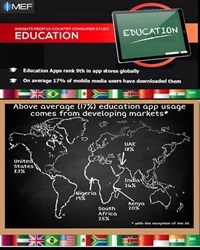MEF has released its third report, with analysed data from 10,000 respondents in 13 countries, in its Global Consumer Insights Series, highlighting both regional and global trends for mobile education products and services.

Click to see the full infographic.
click to enlargeEducational apps rank ninth among all app categories with 17% of mobile media users downloading an educational app globally. This is a slight decline from 20% in 2012 but should be taken in the context of the trend in overall app consumption identified in MEF's Global Consumer Survey which found a growing trend of consumers being more selective about which new services and apps they download.
Greatest in growth markets
Perhaps unsurprisingly, educational app usage is greatest in growth markets. Four of the five countries with a larger than average market for education apps are India, South Africa, Kenya and Nigeria (the fifth is the US).
Also, the use of educational mobile apps is often mandated in these countries. When asked about "motivations for purchase", users in Nigeria, India, Kenya and South Africa were most likely to reply: "I had to for my school/college/university."
Conversely, in developed markets where access to education and the internet is universal, the demand for educational apps is less high.
However, consumers in these markets still display a firm desire for self-improvement, with reference, medical and productivity apps in much higher demand. The global average demand for these products among mobile media users is still low at just 9%, but US mobile media users, for example, consume such apps at much higher rates - 15% (productivity), 17% (medical) and 21% (reference).
Entertainment
Interestingly, many users see education apps as playful or fun rather than just a functional aide to education. When asked what motivated them to buy an app from an educational site, the top answer was 'entertainment' (47% versus 35% of those buying an app from any site). This can be attributed to the successful gamification of educational apps by developers who have introduced gaming concepts such as quizzes, rewards and competition to the learning process.
The report also highlights that educational app users are more engaged with m-commerce than other users, spending more on mobile-related purchases. The research shows that 65% of the total sample makes some form of purchase from their phones. For educational app users, it's 72%. They are also more likely to spend heavily (46% have spent more than $151 on a purchase versus 39%).
Rimma Perelmuter, CEO at MEF said: "Mobile-first markets are clearly driving the uptake of educational apps. This nascent sector has been quick to adopt engagement and business models from other types of app with entertainment and gamification key motivators for consumer uptake.
"A common theme across our Insight Series with reports on Mobile Money and Second Screening is the fact that early adopters are driving mobile commerce across the board. This theme continues, with educational app users who are more likely than the average mobile media user to purchase via their mobile."
























